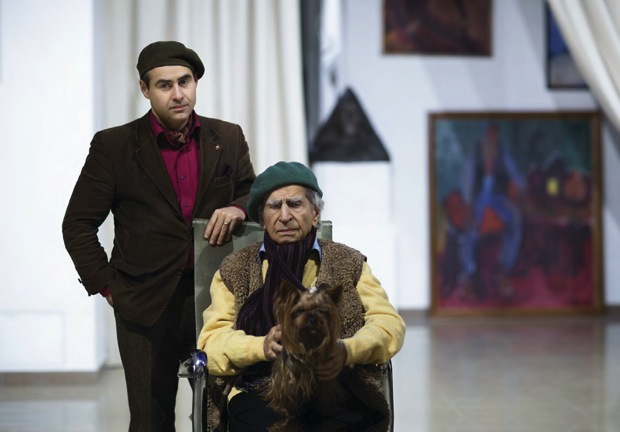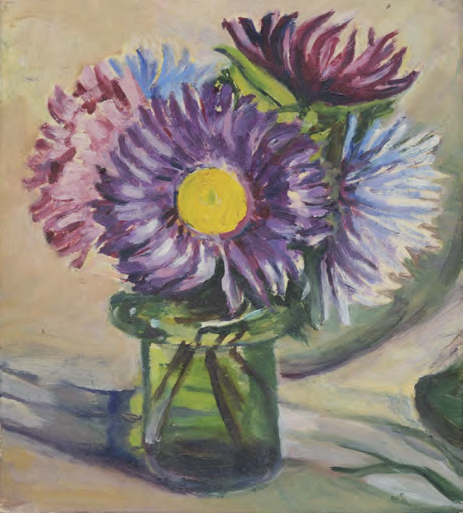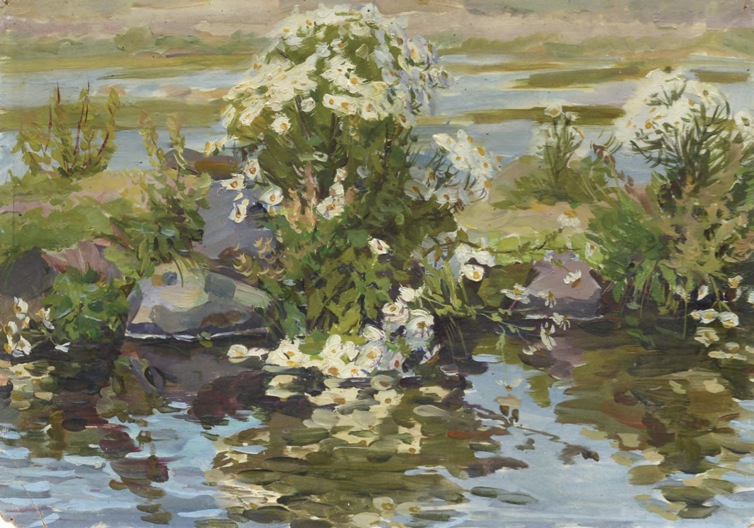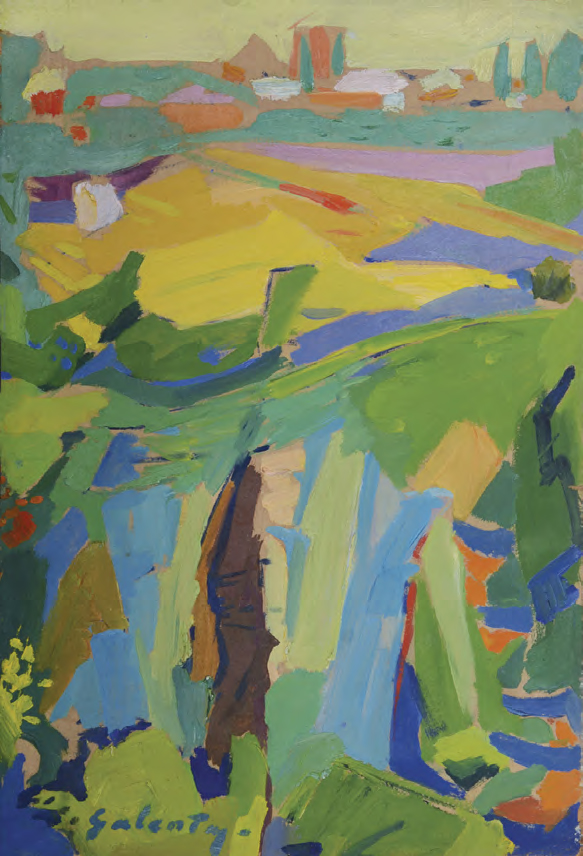Artistic Journeys through National Destinies

Archi Galentz, Nikolai Nikogosyan and Gougen in “Niko” cultural center. Moscow 2016. (Photo by Oleg Tzerbaev)
By Muriel Mirak-Weissbach
Special to the Mirror-Spectator – JUNE 23, 2016
BERLIN — This is a most rare art exhibition. Not focused on one artist or even a school, it presents the works of distinct individuals joined through family ties, whose creative endeavors trace out a multifaceted cultural itinerary across vast geographical expanses through decades of turbulent political and social developments. The show that opened in Berlin on May 14, entitled “Four Life Paths: Two Artist Couples in the Armenian Tradition,” is indeed something very special. The works displayed are by four artists whose lives span a century, from before the First World War to the present. Two are Genocide survivors from Western Armenia, who made their way across the Middle East to Yerevan, whereas the other two were born and raised in Armenia, studied and worked there and in Russia. Through their personal and artistic histories, one encounters life in the diaspora, struggles in the Soviet period and the challenges of the independent Republic of Armenia.
The artists are Mariam Aslamazyan (1907 – 2006) and her brother-in-law Nikolai Nikogosyan (born 1918); Harutyun Kalentz (1912 – 1967) and his wife Armine Kalentz (1920 – 2007). Three of the four continued even after the collapse of the Soviet Union, and their artistic endeavors provide rare insights especially for the younger generation into these two crucial epochs in modern Armenian art. For many young artists active 25 years after the fall of the Berlin Wall, it is difficult to conceive what life at that time was like.
The exhibition at the Kulturhaus Karlshorst, which runs until July 3, is part of the German-Armenian Cultural Days, an initiative taking place this year for the second time, which aims at strengthening the bonds of friendship between the two communities. Among the sponsors are the Association of European and Armenian Experts e.V. (AEAE), the Berlin Lichtenberg Department of Education, Culture, Social Affair and Sports as well as the InteriorDAsein/Berlin artist run space. Curators are Dr. Peter Michel, a leading expert in Soviet art, and Archi Galentz, artist and creator of InteriorDAsein, which houses many of the 30 works on display.
Mariam Aslamazyan.”Astern in a green glass” 2002. (Photo by Archi Galentz)
Perhaps Archi Galentz is the only person who could have put together such an exhibition. All four artists are his ancestors, and most of the works come from his collection, which he received as memoirs, or as pieces to be restored, or to put on display. But it would be wrong to reduce this to a family affair. Certainly, due to his personal relationship to the artists, he has been able to afford the visitor a privileged insight into their careers as well as their personalities. But his aim in presenting these works, shown here together for the first time, is to explore the question raised, not only by them, but by the younger generation that came after, the generation to which Archi Galentz belongs: how should we evaluate that period in art?
The catalogue for the exhibition, itself a little masterpiece, opens with a rich exchange of views between Michel and Galentz on this central theme. In their dialogue on “The Destiny of Artists and History,” art critic Michel noted that “before 1990 in Armenia and in East Germany there were in fact similar developments in the arts.” Following the collapse of the Soviet Union, “it was not a matter of chasing after some nebulous ideas of freedom, but rather of uniting artistic awareness of responsibility with the actually contradictory reality, not to throw grand human ideals overboard, but rather to preserve them and at the same time make people aware of the failures.” Artists in communist East Germany and those in Armenia adopted different means to this end; the former explored “the language of myths” whereas the latter became “conscious of the power of national traditions.” For Galentz, it is important in evaluating the Soviet experience to avoid “simplistic half truths,” for example, by pitting “communism” against “experimentation,” or “freedom” against some “party line” approach. In his view, the value of artistic expression cannot be reduced to formalistic criteria: “Soviet art was … involved in continuing a certain humanistic project, with the question, what kind of society one should live in, and how this sort of man should be, and so forth.”
Michel recalled an observation made by German painter Bernhard Heisig, who said, “The artist’s position in society – even in a socialist society – does not necessarily have to be negative. His significance does not have to lie exclusively in protest against his surroundings.” Such a negative approach in fact has given rise to ridiculous excesses, for example, among those, he said, “who confuse avant-gardism with the progressively creative,” that is, those who think anything “new” is necessarily creative or, that to be creative one has to seek novelty.
The four artists featured in the exhibition found themselves in a historical framework following the collapse of the Soviet Union in which, as Galentz put it, they had to “rediscover painting as their art form and field of interest.” The main theme of the exhibition is “the interconnection of two schools of realism” represented by these four classical artists: concentration in the traditional form of representation was developed by Mariam Aslamazyan and Nikolai Nikogosyan, both born in Armenia, after their education in Russia. As for Harutyun Kalentz and Armine Kalentz, who moved from the diaspora in Lebanon to Soviet Armenia, “it unfolded from the yearning to develop their own national ‘artistic language’ in great variety” in which paint functions as “a means to achieve depth in the canvas.”
Mariam Aslamazyan.”Chamomiles by the River Bank” 1953 (Photo by Archi Galentz)
Related through Art
Mariam Aslamazyan and Nikolai Nikogosyan are considered an artistic “pair” here, not because they were joined in matrimony, but because they worked together in art and had close family ties. Aslamazyan, Archi’s great-aunt, came from Bar-Shirak, a village near Gumri (formerly Leninikan) and had childhood memories of Turkish occupiers in 1918-1920. She studied art there and in Yerevan, as well as Leningrad, where she met fellow art student Nikolai Nikogosyan in 1938. She exhibited in Yerevan and Moscow in the 1930s, and moved to the Russian capital after the war at the same time that Nikogosyan did. In 1944 or 1945, he married a younger sister of hers (there were six girls in the family), and as a result of the close family relationship that developed, “one can consider the two,” Archi says, “as an artist couple. They lived and worked side by side for 60 years.”
Aslamazyan received wide recognition for her work. She was named a member of the board of Armenian Artists Association, was honored for her antifascist stance in the war and in 1990 received the title Peoples Artist of the USSR, but her fame extended beyond the Soviet Union. Her works were exhibited across Europe, in Mexico, Africa, and the Far East; she met world famous personalities like Indira Gandhi and she received prizes in India and Egypt. She loved to travel, and everywhere she went portrayed individuals from different cultural worlds, especially, but not exclusively, women: mothers and grandmothers, peasant women as well as ballerinas and actresses. With an energetic use of bold, bright colors, she also explored architectures and landscapes, be it cloisters in Armenia or city scenes from places like Calcutta and Bombay, Madras and Cairo. “I sought for my language in art,” she wrote. “I drew everything very thick, the color was extremely intensive; I wanted my pictures to make people happy.”
Whereas she was “active in painting, graphic arts and ceramics,” we read in the catalogue, her artist companion Nikogosyan “is known above all as a sculptor who also paints and draws.” Or, as he so aptly put it, “Sculpture is my wife and painting is my mistress.” Born in 1918, Nikogosyan, who is Archi’s maternal grandfather, is still active at 97 and has every intention of continuing. Truly a “living legend of Armenian and Soviet art history,” he left his native village Shagar in 1930 for Yerevan, then studied in Leningrad at the Institute for Painting, Plastic Arts and Architecture of the Academy of Arts. He exhibited as a member of the Soviet Artists Association, won numerous prizes, was named Peoples Artist of the USSR, appeared in 1956 at the Biennale of Venice, and continued to exhibit widely with personal shows. Armenians and foreign visitors know him for his monumental statues, crafted out of a variety of materials — bronze, plaster, wood, marble or granite — portraying, for example Avetik Ishakyan in Gumri and Mikayel Nalbandyan in Yerevan, or the sculpted portraits of Louis Aragon, Aram Khachaturian, Dmitry Shostakovich, the monuments to Komitas Vardapet and the fifth-century historian Moses of Choren, Vladimir Mayakovsky and Yuri Gagarin, among others. Among the pieces on display in Berlin is a profoundly moving piece, a study for a monument to Paruyr Sevak, seated in a pensive attitude.
No less impressive are the countless drawings and sketches by this extremely prolific artist, portraits which capture the psychological essence with great empathy. Among them his self-portraits, from 2006 and after, occupy a special place. They are, we learn, not designed to be ambitious representations of himself, but rather works in which the artist poses questions to himself, sometimes “ruthless, or thoughtful, sometimes bitter or angry…” They are the self-reflections of someone who, at that age, “loses his vanity in the self-consciousness of his life’s achievements and is at peace with himself.”
Harutyun and Armine Kalentz were more properly speaking a couple from the diaspora, Galentz told Michel. Archi’s paternal grandfather Harutyun was born in 1910 in Gürün, in central Turkey, into a family that traced its origins back to princely beginnings in the ancient Armenian capital of Ani. Armine Baronyan was 10 years younger, and came from Adabazari near Istanbul. Both Harutyun and Armine lost their fathers in the Genocide. Armine fled with her mother and siblings across the Syrian border to Damascus. After the death of his mother in an Aleppo hospital, Harutyun and his siblings ended up in an orphanage. It was there that the young boy’s artistic talent was discovered and encouraged. After studying with Armenian artists, he travelled through Syria and Lebanon, and in 1931 started working in Beirut in the atelier of French impressionist Claude Michelet.
It was in Beirut that Armine, who had discovered her own love for art while visiting Italy in the 1930s, met Harutyun and became his student. She worked with him on the Lebanon pavilion for the world exhibition in New York in 1939-40 and in 1943 the two married. Three years later they moved to Armenia, where they held exhibitions together and with other artists who had also returned, and won honors. In 1963, Harutyun was named Outstanding Artist of the Soviet Republic of Armenia and only four years later died young of a heart attack. Armine had begun to exhibit in personal shows internationally in 1963, with repeated appearances in the 1990s in the United States. She died in 2007.
Other times, other places
How has the work of these four artists, in their particular artistic and personal itineraries been received? As Armenian artists active during the Soviet period, how should they be considered? How were their works received, aside from official honors and titles? And how did they assess this experience? Archi Galentz, who has been in Germany for more than 25 years, says one cannot forget that Armenia was once part of the USSR. The men and women whose works he has put on display “were pillars of Armenian national art but also highly revered personalities in Moscow’s greatest museums.” For example, there are 26 works by Nikogosyan in the Tretjakow Gallery and a “Niko” Cultural Foundation is in the process of coming into being in the Russian capital.
It was often said that his grandfather Harutyun Kalentz, though acknowledged as a great artist, had not been truly appreciated. But Archi points out that, after his premature death in 1967, the Yerevan city authorities decided to turn his home into a museum. After the collapse of the Soviet Union, there were those who wanted to present him as an opponent of “the communist regime,” but if that were the case, Archi wonders, why was he spared in the 1940s and 1950s? His grandfather was certainly not a Russophobe, Archi can say for certain, and he must have realized the security for Armenia that Russia could provide at the time. He may have been an opponent but he cannot be classified as an enemy. In the catalogue both aspects of his political personality are reflected: in a brief account of his dismay at learning that the son of an artist colleague had died of starvation, one may see the opponent; yet he crafted a magnificent portrait of a Russian soldier in uniform in 1964 (a work which has curiously disappeared). His grandfather, Archi remembers, managed to walk a fine line, maintaining his independence and integrity. He succeeded in raising two sons and giving them higher education. Blessed with a patron, who purchased his works and introduced them to a circle of connoisseurs, one might think that compared to today, Kalentz lived the life of “a prince of painters in paradise,” says Archi. Living in his own house with a garden, he could paint whenever and whatever he liked, had adequate materials, could entertain guests, drink coffee with them or play his beloved board game nardi (backgammon). In 2010, on the centenary of his birth, the Galentz Museum opened in Yerevan, and in Armenia a commemorative stamp was issued. For his wife, Armine, life in the Soviet Union after 1946 was not easy. But she said she had no regrets about having moved there, since only there could she, as an Armenian women, find fulfillment as an artist.
As for Nikogosyan’s fame in Russia, there are a number of statues he was commissioned to create as a young sculptor, commemorative plaques, and critical studies of the period feature his activity. Aslamazyan, who lived to be almost 100 years old, died in Moscow and rests in the pantheon in Yerevan. In her native Gumri, an Aslamazyan Sisters Museum houses works by her and her sister, Eranuhi. At the same time, as Archi points out, they are also part of the Moscow cultural landscape.
Harutyun Kalentz. “Spring in the Garden” early 1950s (Photo by Archi Galentz)
Distinct Personalities
These four artists, who have shared a common, though differentiated journey through turbulent times in life and art, emerge in the exhibition as highly individualized talents. The curators have taken special care to provide a glimpse of each as a singular personality, by including short passages from their writings. Thus, we read Nikogosyan’s account of a chance encounter with a man who bore a remarkable resemblance to Vincent Van Gogh, and whom he joined in a moving tribute to a deceased poet. We read of how Aslamazyan continued drawing literally up to her dying day. “I don’t get out of the house now,” she wrote in her nineties, “but in any case I get up at eight o’clock every morning and do my exercises, have breakfast and sit down in front of my drawing board. I draw 3 to 4 hours a day, otherwise I cannot live.” In this special collection of thoughts, entitled “Davtar of My Life” (2001), she concluded, “That is all; what comes next, I do not know.” In the same work, she philosophized: “What would happen if one had no dreams? A dream is the beginning of creativity. A dream is the future.”
Armine Kalentz, who exerted a profound influence on her grandson, also recorded her thoughts in a volume entitled, Longing … Valuable Recollections. Armine Kalentz about Herself. In one entry she reflects on the role of the creative person: “An artist is a lucky mediator between God and humanity. He finds the meaning of life in beauty, in that he reflects it in the soul and abandons himself unreservedly to this cause. This striving can also be hard however, when every time, disappointed, it uncovers a truth, and communicates incessantly with death.”
A Curse and a Blessing
When Nikogosyan’s daughter and Kalentz’s son met as art students in Yerevan, they fell in love and married. Their son Archi Galentz is not surprisingly also an artist, who has studied in Russia, Armenia and Germany, his current home. This “artist family dynasty,” as critic Michel puts it, recalls similar families, like the Brueghels, Cranachs and Giacomettis. Was this, he asked, a problem for the younger scion of the family?
Nikolai Nikogosyan.”Smiling Lady” 2005 (Photo by Archi Galentz)
Archi quoted the farmer’s adage that says: ‘Under a mighty tree no grass grows.’ Born into such a family he had to discover himself, find what was truly his own. Through extensive travel, he was exposed to a variety of artistic experiences, yet “the interest in the intellectual heritage of my grandparents stayed with me.” He had to come to terms with this past, in a spirit of respect although not without a critical approach. His heritage he considers both “a curse and a blessing”: a curse, “because some saw me as privileged, as one who could not rebel against the achievements of his forefathers. Most young people do not know the influence exerted by the generation of my grandparents, who lived and worked in a state in which there was injustice.” As for the blessing, this “lay in the fact that already as a teenager I was excited about the euphoria about change taking place in the Soviet Union. And when, from Berlin, I witnessed the collapse, that did not correspond at all to what I had seen in the life and work of my grandparents. So I have been forced to erect my own edifice of ideas, the way archaeologists put together a picture from the pieces of a puzzle.”
Archi did not know his grandfather and namesake Harutyun, who died young, but had the advantage of close relations with the others. Grandmother Armine impressed upon him the need to abide by one’s own convictions. And he enjoys the invigorating company of grandfather Nikolai Nikogosyan — “still, at an advanced age, a very vigorous person to converse with.”
As Kerstin Beurich, District Councilor for Education, Culture, Social Affair and Sports, noted, “Armenian painting is less well known in Germany than Armenian music.” This is certainly the case, and not only in Berlin. All the more reason then for such shows to travel to faraway places. It is to be hoped that this exhibition will be invited to other lands, especially those where the artists worked and exhibited, and where there is a large Armenian diaspora community. Would it not be wonderful to host this exhibition in New York and Boston or Los Angeles?
(Note: Quotes have been translated from the German catalogue text by the author.)

